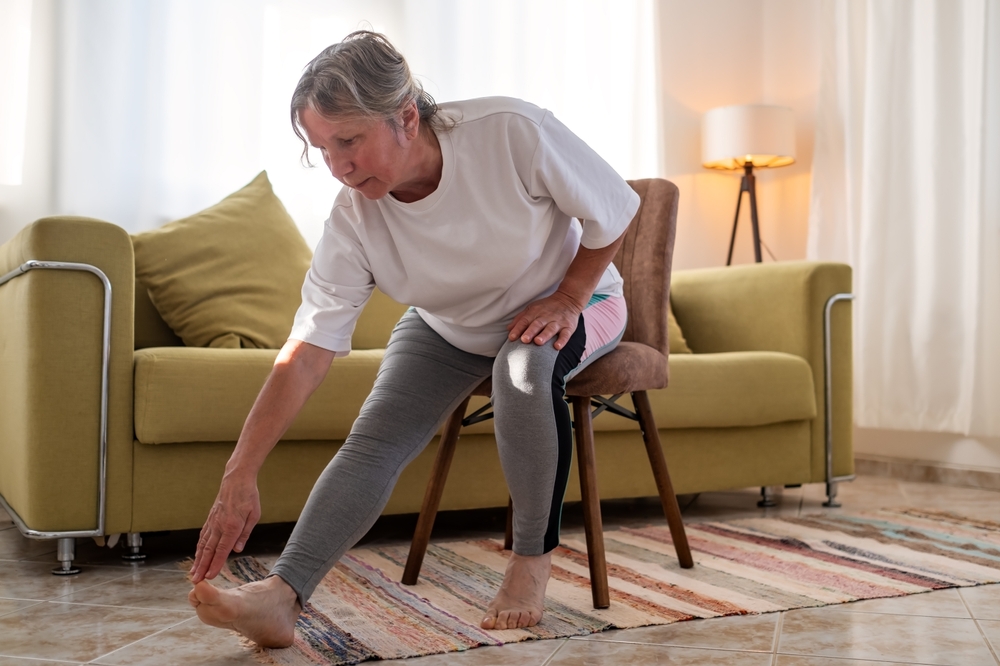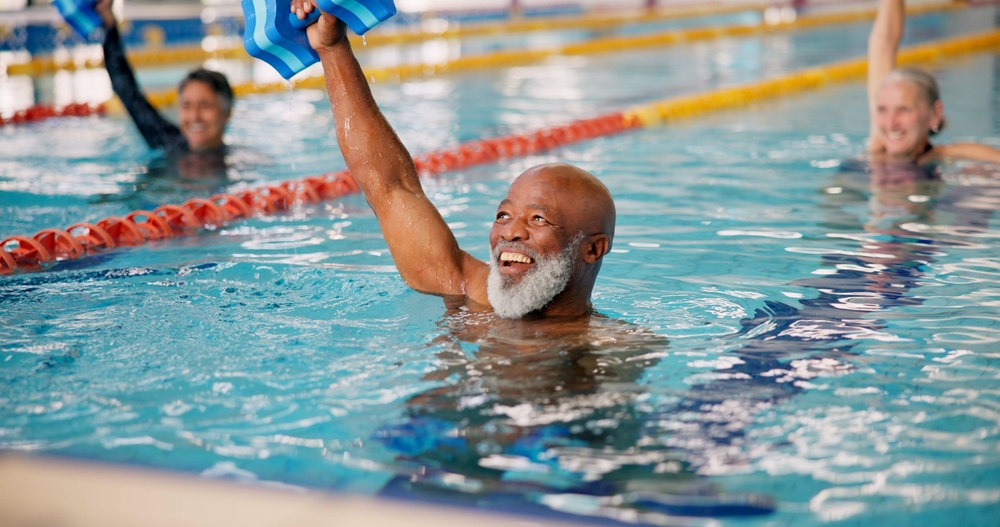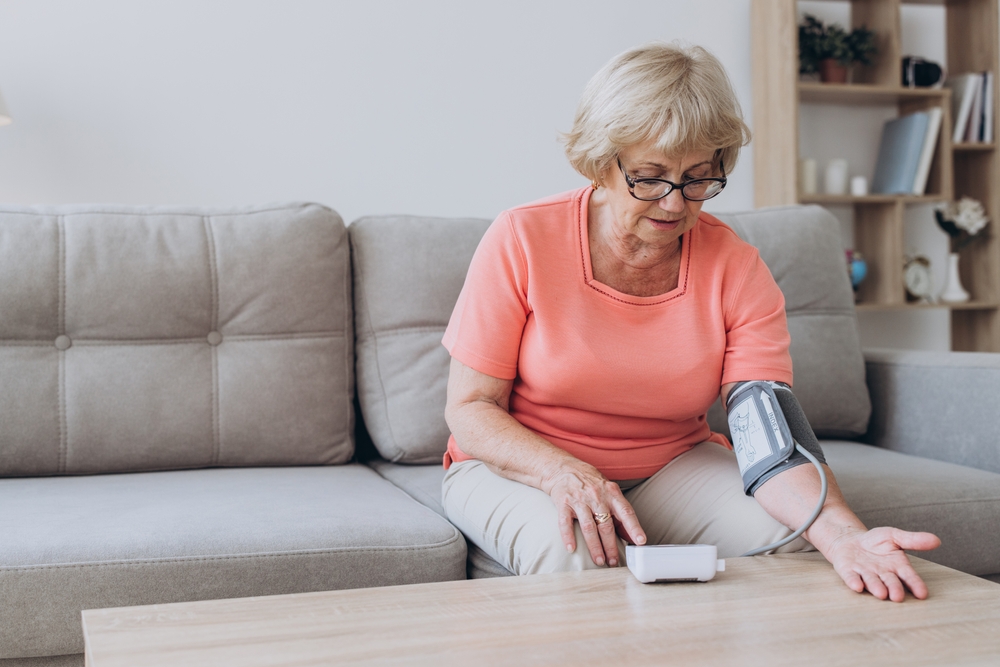Exercises That Help Ease Neuropathy Pain and Improve Mobility

- Exercise improves blood flow to damaged nerves, which can help reduce pain and tingling
- A mix of aerobic, balance, stretching, and strengthening exercises works best for neuropathy
- You don't need intense workouts—gentle, consistent movement makes a real difference
- Specific foot exercises can target numbness, pain, and weakness in your feet and toes
- A Solace chronic pain advocate can help coordinate care with physical therapists and track your progress
Peripheral neuropathy affects millions of people across the country. It causes pain, tingling, numbness, and weakness—usually in the hands and feet. For many people, the symptoms make daily activities like walking, getting dressed, or even sleeping feel impossible.
The healthcare system often treats neuropathy with medication alone. Pills can help manage pain, but they don't address the root problem or help your body function better. Exercise does both. Research shows that regular physical activity can preserve nerve function, promote nerve repair, and reduce pain symptoms.
This guide breaks down the types of exercise that help with neuropathy, specific movements for foot neuropathy, and how to get started safely.

Does Exercise Help Neuropathy?
Yes. Exercise helps manage neuropathy in several concrete ways.
It improves blood circulation to damaged nerves. When you move, your muscles pump blood through your body more efficiently. Better circulation means more oxygen and nutrients reach your nerves. This supports nerve health and can help reduce pain and tingling.
It strengthens muscles weakened by nerve damage. Peripheral neuropathy often causes muscle weakness because damaged nerves can't send proper signals to your muscles. Strengthening exercises help rebuild that muscle function and make everyday movements easier.
It enhances balance and coordination. Nerve damage affects your body's ability to sense where you are in space. This makes falls more likely. Balance exercises retrain your body to stay stable, which protects you from injuries.
It helps manage blood sugar for people with diabetic neuropathy. Exercise helps regulate blood sugar levels. Since high blood sugar causes and worsens diabetic neuropathy, better control can slow nerve damage progression.
It reduces pain and improves flexibility. Movement releases natural pain-relieving chemicals in your body. Stretching keeps muscles and joints flexible, which reduces stiffness and discomfort.
It slows the progression of nerve damage. Studies show that people who exercise regularly experience slower progression of neuropathy symptoms compared to those who don't.
Types of Exercise That Help With Neuropathy
Different types of exercise target different aspects of neuropathy. The best approach combines several types.
Aerobic Exercise
Aerobic exercise gets your heart pumping and blood flowing. This type of movement is one of the most effective ways to improve circulation to damaged nerves.

Walking is the simplest option. Aim for 30 minutes a day, three to five days per week. If that feels like too much, start with 10 minutes and gradually increase. You can split it up—three 10-minute walks spread throughout the day work just as well as one longer walk.
Swimming provides a full-body workout without stressing your joints. The water supports your body weight, which makes movement easier if you have pain or balance issues. Many community centers and gyms offer water aerobics classes designed for people with mobility challenges.
Cycling works well if walking causes too much foot pain. A stationary bike at home or at the gym gives you control over resistance and duration. Outdoor cycling works too, but start on flat, smooth surfaces.
Water aerobics combines the benefits of aerobic exercise with the support of water. Classes often include balance and strength work too.
If you haven't been active recently, start slowly. Even five minutes of gentle movement is better than nothing. Your body needs time to adjust.
Balance Exercises
Balance exercises help prevent falls, which are more common when you have neuropathy. These movements train your body to stay stable even when your nerves aren't sending clear signals.

Single-leg stands are simple but effective. Stand near a counter or sturdy chair for support. Slowly lift one foot off the ground and hold for 5-10 seconds. Lower it and repeat with the other leg. As you get stronger, try it without holding on. Eventually, you can challenge yourself by closing your eyes.
Heel-to-toe walking improves coordination. Walk in a straight line, placing the heel of one foot directly in front of the toes of the other foot with each step. Use a wall or counter for support if needed.
Standing leg raises build hip and thigh strength, which helps with balance. Hold onto a counter for support. Stand straight with feet slightly apart. Slowly lift one leg to the side and hold for 5-10 seconds. Lower it slowly and repeat with the other leg.
Practice balance exercises when you're not tired. Start with support nearby until you feel confident.
Stretching and Flexibility Exercises

Stretching reduces muscle tightness and improves your range of motion. This makes movement easier and less painful.
Calf stretches target tight muscles in your lower legs. Stand facing a wall with your hands on it for support. Step one foot back, keeping that leg straight and pressing the heel into the floor. Bend your front knee slightly. You should feel a stretch in the back of your lower leg. Hold for 20-30 seconds and switch sides. Repeat three times on each leg.
Hamstring stretches loosen the backs of your thighs. Sit on the front edge of a chair with one leg extended straight in front of you, heel on the floor. Keep your other foot flat on the ground with the knee bent. Lean forward from your hips, keeping your back straight, until you feel a stretch in the back of your extended leg. Hold for 30 seconds and switch sides.
Ankle stretches improve flexibility in your feet and ankles. Sit comfortably and slowly roll your ankles in circles, first clockwise, then counterclockwise. Do 10 circles in each direction. For more stretch, point your toes forward and then flex them back toward your shin.
Stretch after any physical activity or when your muscles feel tight. Never bounce during a stretch—move slowly and hold the position steadily.
Strengthening Exercises

Strengthening exercises rebuild muscle that nerve damage has weakened. Stronger muscles support your joints better and reduce strain on your nerves.
Calf raises strengthen your lower leg muscles and improve circulation to your feet. Stand with your feet shoulder-width apart, holding onto a counter or chair for balance. Slowly lift your heels off the ground so you're standing on your toes. Hold for a few seconds, then lower back down slowly. Start with 10-15 repetitions. As you get stronger, try doing them one leg at a time.
Chair squats work your leg muscles without putting too much stress on your knees. Stand in front of a sturdy chair, facing away from it. Place your feet shoulder-width apart. Slowly lower yourself as if you're going to sit down, but stop just before you touch the chair. Hold for a second, then push back up to standing. Start with 5-10 repetitions.
Seated knee extensions strengthen your thigh muscles. Sit in a chair with your back straight and feet flat on the floor. Slowly straighten one leg out in front of you and hold for a few seconds. Lower it back down. Repeat 10-15 times, then switch legs.
Resistance band exercises add variety to strength training. You can use resistance bands to work different muscle groups. A physical therapist can show you specific exercises that work for your needs.
Start with light resistance or just your body weight. You should feel your muscles working, but not sharp pain.

Exercises Specifically for Neuropathy in the Feet
Foot neuropathy needs targeted attention. These exercises focus on the small muscles in your feet and improve circulation to your toes.

Ankle Alphabet
This exercise improves range of motion in your ankle and foot.
Sit in a chair with your back straight. Extend one leg slightly so your foot is off the ground. Use your ankle and toes to "write" each letter of the alphabet in the air. Keep your leg still—all the movement should come from your ankle. Switch to the other foot and repeat.
Do this exercise once or twice a day. It's gentle enough to do while watching TV or reading.
Toe Curls
Toe curls strengthen the small muscles in your feet.
Sit in a chair and place a small towel flat on the floor in front of you. Place one foot on the towel. Using just your toes, try to scrunch the towel toward you by curling your toes down. Don't move your heel. Hold for 2-3 seconds, then release. Pull your toes up and spread them apart. Hold for 2-3 seconds. Repeat 10-15 times, then switch feet.
If you can't actually scrunch the towel at first, that's okay. The effort of trying still works the muscles.
Toe Spreads
This simple movement improves flexibility and circulation in your toes.
Sit comfortably with your feet flat on the floor. Spread your toes as wide apart as you can. Hold for a few seconds. Then curl them downward. Hold again. Repeat 10-15 times on each foot.
You can do this exercise several times a day. It helps reduce stiffness.
Calf Raises
We covered calf raises earlier, but they're especially important for foot neuropathy because they pump blood down into your feet.
Stand near a counter or wall for support. Slowly rise up onto your toes, lifting your heels off the ground. Hold for a few seconds, then lower back down with control. Do 10-15 repetitions, 2-3 times per day.
Foot Rolls
Foot rolls massage the bottom of your feet and stimulate nerve endings.
Sit in a chair and place a tennis ball or lacrosse ball under one foot. Slowly roll the ball back and forth under your foot, applying gentle pressure. Roll for 1-2 minutes on each foot. You can do this while working at a desk or watching TV.
This exercise helps with pain and stiffness. If you have reduced sensation in your feet, watch to make sure the ball doesn't slip out from under you.
Ankle Pumps
Ankle pumps improve circulation and reduce swelling.
Sit or lie down with your legs extended. Point your toes away from you, then flex them back toward your head. Alternate between pointing and flexing 10-15 times. You can do both feet at once or one at a time.
This exercise is particularly good if you have to sit for long periods.
Plantar Fascia Stretch
This stretch targets the arch of your foot and can reduce foot pain.
Sit on the floor or on a mat. Extend one leg with just your heel touching the ground. Reach forward and gently pull your big toe back toward your shin. You should feel a stretch along the bottom of your foot and up into your calf. Hold for 30-60 seconds. Repeat 2-3 times on each foot.
You can also do this stretch standing. Place the ball of your foot on a step or curb with your heel hanging off the edge. Gently lower your heel to feel the stretch.

Getting Started Safely
Exercise helps with neuropathy, but you need to start carefully.

Talk to your doctor first. Before beginning any new exercise program, check with your healthcare provider. They can tell you if there are specific movements you should avoid based on your condition.
Start slowly and build up gradually. If you haven't been active, begin with just 5-10 minutes a day. Add a few minutes each week as you feel stronger. Pushing too hard too fast can lead to injury or make symptoms worse.
Listen to your body. Mild muscle soreness after exercise is normal. Sharp pain, increased numbness, or tingling that lasts more than a few hours after exercise is not normal. If you experience these symptoms, stop and talk to your doctor.
Wear proper footwear. Good shoes with cushioning and support protect your feet. Look for shoes with a wide toe box, good arch support, and a firm heel. Avoid walking barefoot, especially outdoors. Wear seamless socks to prevent blisters.
Check your feet daily. Peripheral neuropathy can reduce sensation in your feet, which means you might not feel cuts, blisters, or other injuries. Check your feet every day for any signs of damage. Look between your toes and on the bottoms of your feet.
Consider working with a physical therapist. A physical therapist can create a personalized exercise plan based on your specific symptoms and limitations. They can also teach you proper form to prevent injuries.
Know the difference between good pain and bad pain. Muscle fatigue and mild soreness are signs your body is working. Sharp, shooting pain or pain that gets worse with movement means something is wrong. Stop immediately if you feel bad pain.
Making Exercise Part of Your Routine
Starting an exercise routine is one thing. Sticking with it is another.
Set realistic goals. Don't expect to exercise for an hour every day if you haven't been active. Start with 10 minutes three times a week and build from there. Small, consistent efforts add up over time.
Track your progress. Keep a simple log of what exercises you do and how you feel afterward. This helps you see improvements that might be gradual. It also helps you identify which exercises work best for your symptoms.
Find exercises you actually enjoy. You're more likely to stick with movement that doesn't feel like a chore. If you hate swimming but love dancing, do that instead. The best exercise is the one you'll actually do.
Exercise with a friend. Having someone to exercise with makes it more enjoyable and keeps you accountable. Even a regular phone call while you both walk in your own neighborhoods can help.
Break up activity throughout the day. Three 10-minute walks spread across the day work just as well as one 30-minute walk. This approach often feels more manageable when you're dealing with chronic pain or fatigue.
Celebrate small victories. Notice when standing on one leg gets easier or when you can walk a little farther without discomfort. These improvements matter, even if they feel small.

What Can Make Neuropathy Worse
While you're working on helpful habits, it's worth knowing what makes neuropathy worse.
High blood sugar levels are the biggest culprit for people with diabetic neuropathy. Uncontrolled diabetes accelerates nerve damage. Exercise helps, but it needs to be combined with proper blood sugar management.
Smoking and excessive alcohol both damage nerves and reduce circulation. If you smoke, quitting is one of the best things you can do for neuropathy. Limiting alcohol helps too.
Tight shoes or prolonged standing can worsen foot pain and numbness. Wear supportive, well-fitting shoes. Take breaks to sit down if your job requires long periods of standing.
Ignoring warning signs leads to bigger problems. If you notice increased pain, new numbness, or other changes in your symptoms, talk to your doctor. Don't push through sharp pain during exercise.
Not managing the underlying condition means the neuropathy will likely progress. Whether your neuropathy comes from diabetes, chemotherapy, vitamin deficiencies, or another cause, treating that underlying condition is essential.
How a Solace Advocate Can Help
Managing neuropathy involves more than just exercise. You're dealing with multiple doctors, treatments, medications, and insurance questions. A Solace advocate cuts through that complexity.
We coordinate with physical therapists and specialists. Your advocate ensures everyone on your care team communicates. If your physical therapist recommends specific equipment or exercises, we make sure your primary doctor knows. If you need a referral to a pain management specialist, we handle that.
We track which treatments and exercises are working. It's hard to remember what you tried three months ago and whether it helped. Your advocate keeps organized records of your symptoms, treatments, and progress. This information helps your doctors make better decisions about your care.
We follow up on referrals and manage appointments. Getting in to see a physical therapist shouldn't take six phone calls and three months of waiting. We handle the scheduling, insurance verification, and follow-up so you can focus on getting better.
We help you communicate symptoms and progress to your care team. Explaining how neuropathy affects your daily life can be difficult. We help you document your symptoms in a way that doctors understand. We join appointments to make sure your voice is heard.
We ensure your diabetes management plan is on track. If you have diabetic neuropathy, controlling blood sugar is critical. We coordinate between your endocrinologist, primary care doctor, and other specialists to make sure everyone is working together.
We take the administrative burden off your plate. You shouldn't have to spend hours on the phone with insurance companies when you're dealing with chronic pain. We handle the paperwork, prior authorizations, and claims issues so you can focus on your health.

Frequently Asked Questions
Can exercise actually reverse neuropathy?
Exercise can't fully reverse nerve damage that's already happened, but it can help manage symptoms and slow progression. Regular physical activity improves blood flow to nerves, which supports nerve health and can help damaged nerves function better. Some people do see improvement in their symptoms with consistent exercise, especially when combined with proper treatment of the underlying cause. The key is starting early and staying consistent.
How soon will I notice improvement from exercising?
Most people start noticing some improvement within 4-8 weeks of regular exercise. You might see better balance first, or less muscle weakness. Pain reduction often takes longer—sometimes 3-6 months. Remember that progress isn't always linear. Some days will feel better than others. Keep a log of your symptoms and exercises so you can look back and see improvements that might feel gradual day-to-day.
What should I do if exercising makes my pain worse?
Stop the exercise immediately if you feel sharp or shooting pain. Mild muscle soreness is normal, but increased nerve pain is a warning sign. Rest for a day or two, then try again at a lower intensity. If the pain continues, talk to your doctor or physical therapist. You might need to modify the exercise or try different movements. Never push through nerve pain—it won't make you tougher, it'll just cause more damage.
Are there any exercises I should avoid with neuropathy?
High-impact activities like running or jumping can be hard on feet with reduced sensation. You might injure yourself without realizing it. Exercises that require perfect balance without support can lead to falls. Avoid movements that cause sharp pain or increased numbness. Generally, low-impact activities like walking, swimming, cycling, and gentle strength training are safest. Your doctor or physical therapist can give you specific guidance based on your symptoms.
Do I need special equipment to do neuropathy exercises?
No. Most effective neuropathy exercises require little or no equipment. A sturdy chair, a hand towel, and a tennis ball will cover most of the exercises in this guide. If you want to add resistance training, a simple set of resistance bands costs less than $20 and works for dozens of exercises. Good supportive shoes are the most important investment. Everything else is optional.
This article is for informational purposes only and should not be substituted for professional advice. Information is subject to change. Consult your healthcare provider or a qualified professional for guidance on medical issues, financial concerns, or healthcare benefits.
Related Reading
- Understanding Your Neuropathy Treatment Options
- Can Diabetic Neuropathy Be Reversed? Lifestyle, Treatment, and Realistic Guidance
- Best Shoes for Neuropathy: Do You Need Special Footwear & Will Medicare Cover It?
- How Patient Advocates Help With Neuropathy Pain Documentation
- What Are the Worst Foods for Neuropathy?


Learn more about Solace and how a patient advocate can help you.
- Healthline: Exercises for Peripheral Neuropathy: Aerobics and Stretching
- Loma Linda University Health: 4 Exercises to Reduce Chronic Nerve Pain
- The Foundation for Peripheral Neuropathy: Exercise & Physical Therapy
- Upstep: 5 Daily Exercises for Peripheral Neuropathy Relief
- Family Foot and Ankle Center of South Jersey: Try These Exercises to Ease Your Neuropathy Pain
- Cancer Rehab PT: 11 Exercises for Neuropathy in Feet to Feel Better
- KindlyMD: Exercises for Neuropathy Relief
- National Center for Biotechnology Information: Exercise for Neuropathic Pain: A Systematic Review and Expert Consensus

.svg)
.png)


